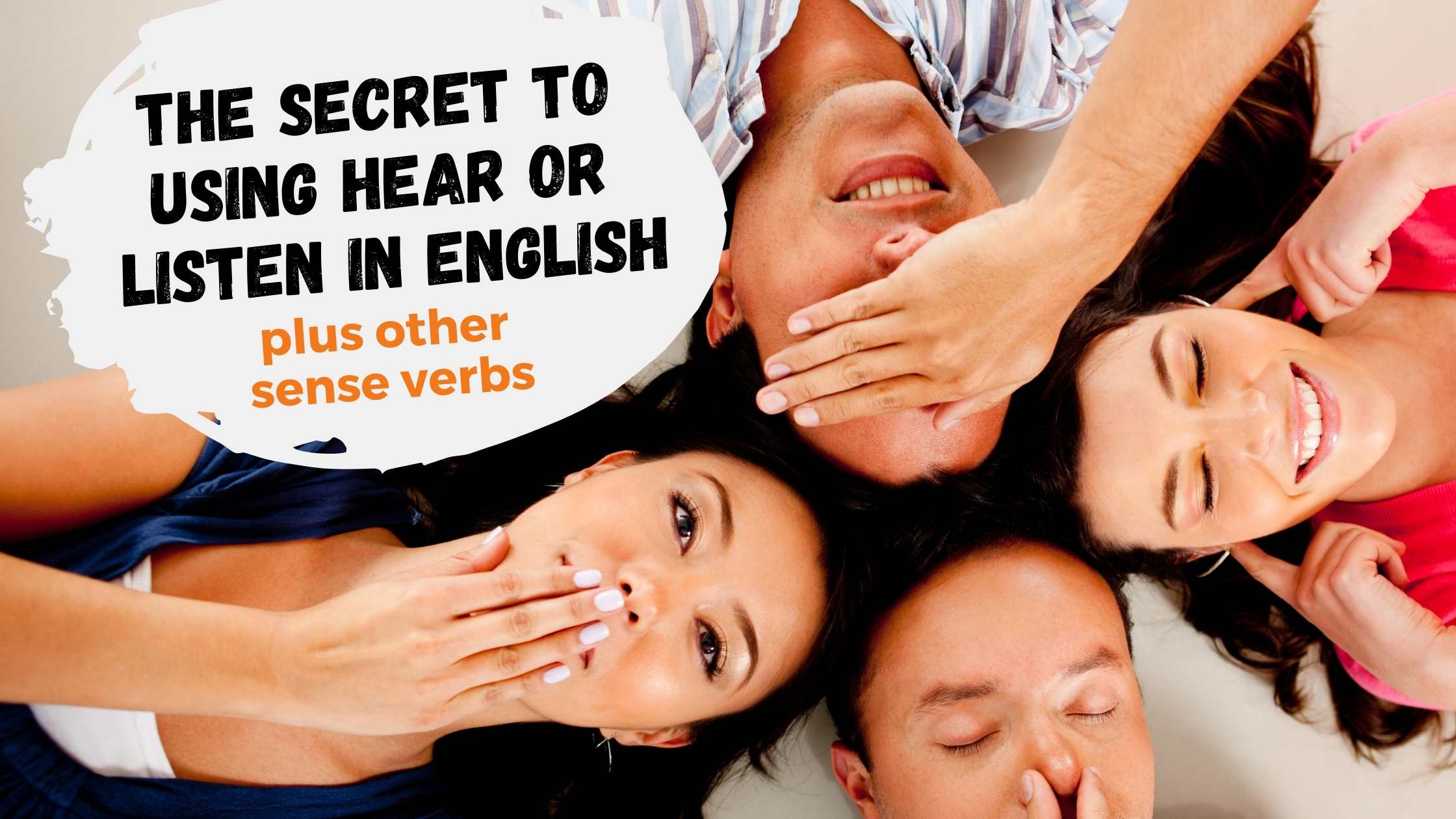The Secret to Using Hear or Listen in English, Plus Other Sense Verbs
True or false: hear and listen mean the same thing. Turns out, these two sense verbs in English don’t mean the same thing! Well, they kind of do, but not exactly. That was a trick question.
One common mistake with new English speakers is not using these two words correctly. Or only using one of them. This blog post will finally answer your questions about words like hear, listen, see, watch, look, touch, and feel.
Let’s start with some explanations and examples in English for hear and listen.
The five senses in English
Sense verbs (or sensory verbs) describe the five senses: hearing, smell, sight, taste, and touch. Our senses are how we understand everything that happens around us. Here are some words that we use to talk about each one of the senses and some examples of sentences using those words.
Hearing
We hear with our ears. If you don’t remember the vocabulary for parts of the body, this may be a good time to review them!
Your ears are necessary for you to recognize sounds around you. Your sense of hearing is what makes you able to listen to music, hear conversations, and identify sounds. If your TV is too loud, for instance, your sense of hearing will tell you to turn down the volume. If there’s too much noise coming from your neighbor’s house, you may want to close your window. Here are two examples of sentences about the sense of hearing:
- If you are really quiet, you can hear the birds in the distance.
- Please turn down the volume, it is too loud.
You can describe sounds you hear using the verb sound. Here are some examples:
- I hear a noise. It sounds like a dog.
- Listen to this message. It sounds like my mom.

Some people have difficulty with this sense, and they are hearing impaired (partial loss of hearing) or deaf (total loss of hearing). However, there is some amazing new technology that can help some people with hearing loss recover this sense.
Sight
Our eyes are the cameras of the body. They capture visual information and send it to the brain to be processed. This is how we see.
You can describe sights you see using the verb look. Here are some examples:
- What do you see? It looks like a fire.
- Be careful out on the water. It looks dangerous.
Some people have difficulty with this sense. They are visually impaired (some loss of sight) or blind (total loss of sight). Some people need glasses or contact lenses to help them see if they have some loss of sight.
Most people think that sight is the most powerful sense, because humans depend so much on what we see. It is the sense that allows us to read, write and create art. It is the sense that we use almost all the time, that defines the time we are awake. Of all the senses, the brain dedicates the most space to processing visual cues. However, it is not necessarily the most powerful sense.

Smell
Did you know that humans can identify 10,000 different scents with their nose? Interestingly, people are not good at describing smells, across many languages and cultures. Do you relate? Then this may be a good time to learn some words used to describe smell.
Your sense of smell is what allows you to identify good scents and unpleasant odors. Some people are more sensitive to smell than others. For some people, sweet perfumes are a no-no, while others don’t get bothered by this specific scent. Here are two examples of phrases related to the sense of smell:
- Don’t you think that the smell of vanilla is very soothing?
- We smelled the aroma of freshly baked cookies when we entered the house.
Sometimes, people lose their sense of smell as a result of some disease or injury. This can be temporary or permanent. Without the smell sense, food can lose much of its taste too.

Taste
Your tongue is how you perceive the flavor of things you eat or drink. There are around 10,000 taste buds on the average tongue which send signals to the brain to identify the sweet, sour, salty, and bitter flavors. We tend to experience stronger bitter tastes towards the back of our mouth, while sweet tastes are perceived at the front.

Touch
The skin, which is the largest organ of the human body, is how understand our sense of touch. The skin is packed with many sense receptors, and these allow us to tell if something is hot or cold, dull or sharp, wet or dry, and rough or smooth. Basically, we feel textures and temperatures.
| Sense | Part of the body | Action verb | Passive verb | Sensory verb |
| Hearing | ears | listen | hear | sound |
| Sight | eyes | look (at) / watch | see | look |
| Taste | mouth and tongue | taste | taste | taste |
| Smell | nose | smell | smell | smell |
| Touch | skin | feel | feel | feel |
Sense verbs in English
Now that you know more about each sense, let’s go over the difference between some confusing sense verbs in English we often use to talk about our senses. Let’s get started!
Listen vs. hear
Both these sense verbs in English are used to talk about the sense of hearing. Listen is a regular verb, and its past form is listened. On the other hand, hear is an irregular verb, and its past form is heard.
Definition: listen means to hear sound consciously. When we listen to something, we are concentrated and paying attention to it.
Use: Remember that the verb listen requires an object, which is always followed by the preposition to. Here are two examples:
- I love listening to music before going to bed.
- My boss listened to my pitch, so he must be interested.

Hear is a verb that means understand sounds that come to our ears, but we are not actively paying attention to. Take a look at these examples:
- I think I heard something coming from the back of the house. Did you hear anything?
- My dad can’t hear very well. I should take him to the doctor.
See vs. look vs. watch
There are three verbs that have to do with sight: see, look and watch. They are similar, but you should know the rules about how to use each one.
See
The verb see means that your eyes receive visual information, but you are not necessarily paying attention to. This is an irregular verb and its past form is saw. Here are two examples of sentences using see:
- I hope we can see dolphins when we go snorkeling.
- It was very dark there, and he could not see anything.
Look and Watch
On the other hand, look and watch are action sense verbs in English. That means that they never happen automatically. We use look to suggest a direction for our eyes. Remember to use the preposition at after the verb look if you want to identify an object.
For instance, “Kelly, look at this picture. Do you recognize this girl?”
Watch is used for ctions that need concentration. We use this verb to in situations like: watch a movie, watch a TV show, or watch a soccer match. Watch is a regular verb and its past form is watched. Here are three examples of sentences using watch:
- She is watching a movie in her bedroom.
- My grandpa always watches soccer matches on Sunday.
- My sister never watches TV. She prefers reading books.

Speak vs. Tell vs. Talk vs. Say
Again, here is a situation where there are four verbs that are similar, but used differently. Let’s go over how to use speak, tell, talk and say.
Speak
We use the verb speak for languages, speeches, and important conversations. Speak is an irregular verb and its past form is spoke. Here are some examples:
- Language:
I can speak English and Italian. - Important conversation:
Can I speak with Dr. Jones, please? - Important conversation:
I need to speak with you as soon as possible. - Speech:
I hate speaking in public. I get really nervous.
Tell
On the other hand, we use the verb tell to give information or instruction to someone else. With tell, you always have to include an object of the verb. Who do you tell? Also, this verb is irregular, so the past tense is told. Take a look at these examples:
- Phil, please tell me the truth.
- I told my mom I was pregnant and she started telling everyone in the family about it.
- Louise told me she is not coming to work today. She has the flu.

Talk
Talk is used to refer to conversational exchanges and informal communication. Often, you use “to” after talk to indicate the object of the verb. Who do you talk to? And hey, here’s some good news! Talk is a regular verb, so its past form is talked. Check out some examples of sentences using this verb:
- Do you want to talk after lunch?
- You shouldn’t talk to strangers
Say
The last verb to review is say. With this verb, you can have an object, but it’s not necessary. If you do indicate the object of the verb, use the prepostion “to”. We use say to report something that someone else has said. The past form of this irregular verb is said. Here are some examples:
- The teacher said that I did a good job on the test.
- She says she is not going to class today.
We use sense verbs every day to describe the world around us. Challenge yourself to go beyond what you see or feel, and talk about taste, sound, and smell. Learn new adjectives in English that elevate your descriptions. Plus, watch out for those tricky English words like hear, listen, sound, touch, feel, look, see, and watch. The ability to understand the differences is essential for any English learner.

